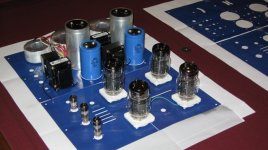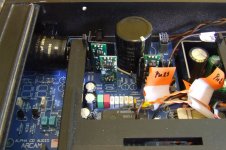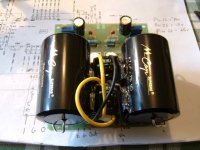Andrew,
I look forward to your results. The description you post is what I should have written about the effect of the 200pf cap!! If he is seeing yet another jump, that's quite alot. I hate to be dramatic, but in my case based on 45mins sample I would class it as a different machine. Results were not small.
good luck with your work.
I look forward to your results. The description you post is what I should have written about the effect of the 200pf cap!! If he is seeing yet another jump, that's quite alot. I hate to be dramatic, but in my case based on 45mins sample I would class it as a different machine. Results were not small.
good luck with your work.
. No; I'm damn sure what you are hearing is the effect of (your) implementation of regulators... and supply decoupling. These have a simply massive effect on the TDA1541 sound quality (and the SAA720 for other reasons).I like the idea of the 1541 losing a bit of excess colouration as I do find it emphasises the upper bass and lower mids a bit too much.
Yes there are lots of other tricks too but making good regs really work is worth the effort over just replacing the 7805 or whatever it originally had like-for-like. Kick-*** dynamics, for one thing...
Hmm, I'm a little sceptical. I doubt I'm missing that much with my almost direct and dedicated super-regs. I think you've also not seen how my machine is modified. I've not replaced many regs, most are added in new locations... though the DAC board regs are, admittedly, in the same locations as stock.
Simon
Simon
I like the idea of the 1541 losing a bit of excess colouration as I do find it emphasises the upper bass and lower mids a bit
Simon
I had the same impression. I was very happy with it, but there was a bit of an emphasis as you state. I have not measured my speakers, but they are likely a bit bright. As I kept getting more clarity thru changes to the arcam and to my linestage, I was beginning to think I needed to work on my speakers as the sound was becoming too edgy in the upper registers. The vocal hiss had a harsh edge on some recordings. Words like this or kiss had a sizzle at the end. Following the reclocking, this has disappeared. I'll comment more after I thoroughly listen to this 'new' machine.
Real is the new impression. Loads of micro information in the background. I ran a few samples of classical and opera. My system was doing great on Jazz and blues, but it was not really up to classical. A little muddled. I figured that I'd need to defer that to when I get around to addressing the speakers or even the amp. Not so. This stuff just jumped to life.
My main project is long a long slow run at building my first tube amp. I think getting the source really right will be important before this comes online. Its clear that my current amp is not the limitation, it remains the source.
Here's a preview of the amp project, btw - just finalizing the layout. Very exciting..
Attachments
Hmm, I'm a little sceptical. I doubt I'm missing that much with my almost direct and dedicated super-regs. I think you've also not seen how my machine is modified. I've not replaced many regs, most are added in new locations... though the DAC board regs are, admittedly, in the same locations as stock.
Simon
... and supply decoupling. These have a simply massive effect on the TDA1541 sound quality (and the SAA720 for other reasons).
I was sceptical about the audible effect of regulators & supply decoupling caps mods.
I have been messing with an old Philips CD471 (tda1541)-trying I/V transformers, LC filters etc whilst awaiting the arrival of a dual differential 1541a based kit.
So I chopped off the 30year old supply decoupling caps and soldered Oscons direct to the IC pins (just the 5volts ones - couldn't get at the -15v pin).
I was pleasantly surprised how audible the result was. Its hard to put it into words - everything was a bit clearer, sharper, more focussed and bass tighter. A bit like a veil has been lifted off the speakers.
Exactly, its the very detail of the implementation that matters - often more than the parts. Another example, a reg's performance is limited where it is is sampling the supplied voltage. If that is 10cm away from the load device, across thin tracks sharing noisy currents with other circuits, then its benefit is often degraded badly. It's always worth a good think about how 'good' drop-in 3pin reg replacements can perform from this POV.
Related to this - a good reg similarly remote from the circuit it serves but with a high-quality output cap onboard might have made the HF 'current loops enormous and noisy - because the local decoupling cap is old/dried out/not very good at RF and so on. Decoupling should be as tight as (and as good as) you can arrange, right at the load, not the reg!
These are the things I was getting at before I lost the original post I was going to stick up last night!
Related to this - a good reg similarly remote from the circuit it serves but with a high-quality output cap onboard might have made the HF 'current loops enormous and noisy - because the local decoupling cap is old/dried out/not very good at RF and so on. Decoupling should be as tight as (and as good as) you can arrange, right at the load, not the reg!
These are the things I was getting at before I lost the original post I was going to stick up last night!
Last edited:
Andrew, that really sucks. What's the problem?
batteryman,
Good to hear your experiences. I'm using os-con SEPCs on the -5 and +5V DAC supplies. I find such changes are audible but nothing like the BIG veils that come off with good regulation and dedicated power supplies. You will like that if you've not gone there yet. I found the smoothing caps on the DAC supplies to be really crucial too!
batteryman,
Good to hear your experiences. I'm using os-con SEPCs on the -5 and +5V DAC supplies. I find such changes are audible but nothing like the BIG veils that come off with good regulation and dedicated power supplies. You will like that if you've not gone there yet. I found the smoothing caps on the DAC supplies to be really crucial too!
Andrew, that really sucks. What's the problem?
batteryman,
Good to hear your experiences. I'm using os-con SEPCs on the -5 and +5V DAC supplies. I find such changes are audible but nothing like the BIG veils that come off with good regulation and dedicated power supplies. You will like that if you've not gone there yet. I found the smoothing caps on the DAC supplies to be really crucial too!
The Dac kit from rainbow_hui on ebay appears to feature discrete regulators (haven't received it yet) so here's hoping they sound better than IC regulators. I'll be upgrading some of the caps as well,not to mention converting it to dual differential and listening out for the benefits of dem reclocking and i2s attenuation.
BM
If that is 10cm away from the load device, across thin tracks sharing noisy currents with other circuits, then its benefit is often degraded badly. It's always worth a good think about how 'good' drop-in 3pin reg replacements can perform from this POV.
Hello Martin,
Have you seen inside an Arcam Alpha? Specifically, the DAC / output board that Arcam use to differentiate it from the stock Philips design? The -15V reg (LM337 as stock) feeds the -5V reg. Same with the +15 and +5 regs. These then feed the op-amps (removed on my model) and DAC's +5, -5 and -15V. What do you think of this cascaded sort of regulation? I left it as standard for now but thought it might be better done "directly".
What do you think of the layout? Are these regs too far away for high performance? I thought not but you seem to be getting at something, unless that wasn't directed at me (it felt like it was as I am using the good regs round here!)
Thanks
Simon
Attachments
The Dac kit from rainbow_hui on ebay appears to feature discrete regulators (haven't received it yet) so here's hoping they sound better than IC regulators. I'll be upgrading some of the caps as well,not to mention converting it to dual differential and listening out for the benefits of dem reclocking and i2s attenuation.
BM
I can't see discrete being as good as typical "super" type regs using an op-amp but maybe it brings something interesting to the party. It'll be interesting to see what you think of those other tweaks.
The vocal hiss had a harsh edge on some recordings. Words like this or kiss had a sizzle at the end. Following the reclocking, this has disappeared.
Re-clocking is great at removing that fuzz and sizzle from the edges of treble notes. It's the same in a CD63. You should, however, still expect to hear some unpleasant exaggeration of sibilant sounds (those sssshhh noises, mainly on female voices) because some of it is from using cheap microphones, which most recordings use. If it's there it should be reproduced. The goal is to hear recordings warts and all but not to exaggerate those warts. I find the 1541's basic character to be one of omitting certain details but not making a mess of anything that it does reproduce. The lack of detail is not just layout and other clever things only smart blokes know about, it's got to be intrinsic to the design to a point.
That's the bit I was really addressing. I certainly do not think it is a limit of the 1541, it's capable of retreiving everything on a CD (ie distortion closely approaching the full 16bits equivalent - the 63's NPC dac doesn't get anywhere near!) and intrinsic S:N of about -110dB - still very, very good for dac of any architecture.it's got to be intrinsic to the design to a point.
Not sure what you are using for the I/v stage Simon but it is critical to getting the best out of this DAC. IIRC some arcams had OP27s in there - a more ill-suited part I can hardly imagine, though it sounds very 'polite'.
The point about cascaded regs - I'll have to have a look at the Arcam's manual this weekend. I can think of one way it may not help - the internal current source reference in the 1541 is between the -15 and -5 supplies; keeping a constant 10v between these two supplies is more important than it appears and the reg cascade is going to do some (ahem) interesting things to that.
With a conventional hookup of -5 and -15 regs you can experiment with a small but good cap between the -5 and -15v pins of the dac* This one extra cap - say a 10uF oscon - closes the loop and helps maintain this 10v difference nice and quiet at HF, where it matters
(With the regs in cascade this extra cap would be an AC connection across the -5v reg input to output and probably result in a power oscillator or, at the very least, negate the point of having a regulator there - beware!)
* if you have a scope you may find adding a bit of RC damping at the output of one or both regs to 0v is required for best stability / effect.
Last edited:
Very cool post, thanks! I'm using the Pass D1 output stage with quality parts and S Power regs (and the usual huge, dedicated 100VA supply with good smoothers). I love this output stage though as a Naim guy I think you might not agree!!!! It is exceedingly polite / smooth / warm / full.
Attachments
Without valves eh??? LEDs then I suppose! 
I've got some ideas to mull over now. I've contemplated substituting the feedback resistors on the -5 and -15V S Powers for a resistor + trimpot to achieve a perfect 10V between them but, being honest, thought I'd break them as it's all surface-mount there. Is it worth the risk? Will I hear a gain?! I'm curious.
I've got some ideas to mull over now. I've contemplated substituting the feedback resistors on the -5 and -15V S Powers for a resistor + trimpot to achieve a perfect 10V between them but, being honest, thought I'd break them as it's all surface-mount there. Is it worth the risk? Will I hear a gain?! I'm curious.
It would be more effective to feed the -5reg from the same rail that feeds the -15v reg, then try the extra cap. The -5rail only draws about 30mA, so the reg will be ok heatwise dissipating c.0.5w if run off (say) -22v; no extra heatsinking required.
If the rail to the -15v doesn't have a little bit of RC decoupling ahead of the -15v reg, add some. 10ohms and a 10-100uF is enough. It will clear-up noise that otherwise passes right through regs - the 1541 seems sensitive to this to my ears (the -15v goes to the substrate that everything is built off in the dac - you can see in the datsheet this pin has the worst PSRR)
If the rail to the -15v doesn't have a little bit of RC decoupling ahead of the -15v reg, add some. 10ohms and a 10-100uF is enough. It will clear-up noise that otherwise passes right through regs - the 1541 seems sensitive to this to my ears (the -15v goes to the substrate that everything is built off in the dac - you can see in the datsheet this pin has the worst PSRR)
Arcam used RC decoupling on the psu for the +-20V (feeds the DAC and op-amps). When I upgraded the smoothing caps I also deleted the RC filtering and the sound quality gain was about the biggest ever from this player. I'm now seriously sceptical about using RC decoupling on the DAC supplies... though I used RC and LC filtering on my SAA7220 and SAA7310 supplies and got a slight gain in SQ. These were massive banks of caps before and after the L/R. I also used LC filtering on my clock supply, which also seemed to improve the SQ a tiny bit.
I seem to have some conflicting circumstantial and incomplete evidence regarding RC filtering in the cd player. I'm not sure what noise I'm removing from the DAC PSU as it's not shared with anything. The transformer, PSU and regs purely feed the DAC's 3 power pins. I'm sure there's ripple and noise from the AC, but I don't know how much.
I seem to have some conflicting circumstantial and incomplete evidence regarding RC filtering in the cd player. I'm not sure what noise I'm removing from the DAC PSU as it's not shared with anything. The transformer, PSU and regs purely feed the DAC's 3 power pins. I'm sure there's ripple and noise from the AC, but I don't know how much.
- Status
- This old topic is closed. If you want to reopen this topic, contact a moderator using the "Report Post" button.
- Home
- Source & Line
- Digital Source
- Arcam Alpha mods


